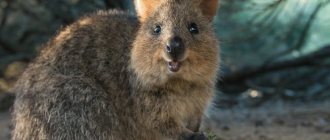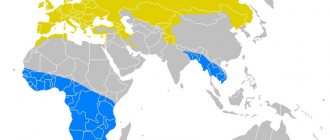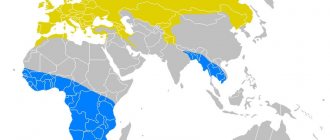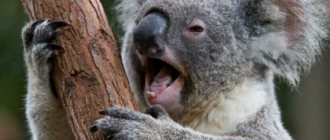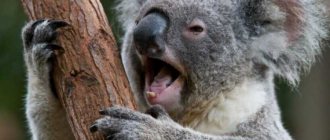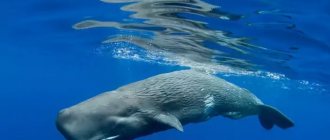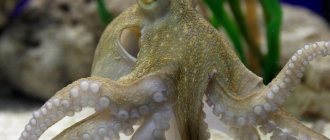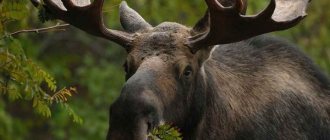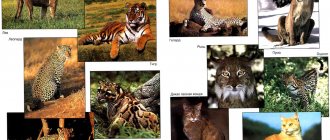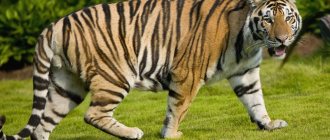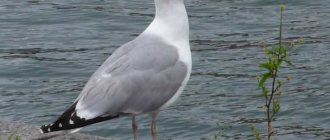Koalas are cute creatures that can often be seen on tree branches. Thanks to their passive and measured lifestyle, round shape and miniature eyes, they resemble plush toys. And their drowsiness and laziness often become reasons for jokes in cinema and animation. However, creatures that are simple at first glance have many interesting features and traits unique to their species.
Koalas spend most of their lives in trees
Origin of the species
Scientists still cannot come to a conclusion when exactly these animals appeared. Some believe that their distant ancestors lived during the late Miocene: 11-5 million years ago. Others believe that the first koalas began to populate Australia in the Pliocene: 5-3 million years ago.
Since the herbivore has practically no family ties with other animals, despite some common features with bears, it is not possible to more accurately establish their ancestors and evolutionary features.
Koalas are not easy to spot in trees
Security measures
Due to the fact that most of the traditional habitats of these animals were destroyed, only scattered populations have survived today. About a hundred years ago, koalas were on the verge of extinction. The people who were attracted by the soft and expensive fur of these animals were to blame for this. In 1924 alone, over two million koala skins were exported from Australia.
Today, koalas are under special protection; their extermination is prohibited. Koalas are bred in zoos and nature reserves, restoring their populations.
History of discovery
Since these animals live in Australia, history experts can assume that they were first discovered by Tim Cook, a famous traveler who discovered these lands in 1770, after which he equipped expeditions several more times. However, the navigator did not meet the koalas due to simple bad luck. Since the animals spend all their time in the trees and move little, travelers who did not even think of looking at the eucalyptus branches lost sight of them.
Humanity first became acquainted with these animals in 1802, when the governor of New South Wales received a parcel from a soldier, Barallier.
Inside the box he found the carcass of an unknown creature preserved in alcohol. This find aroused great interest among scientists, and they began to study it. However, a year later people met koalas in person, and some time later a large article was published in one of the scientific journals, describing this animal in detail. Interesting fact : despite the fact that koalas live only in Australia, their habitat covers a million square kilometers.
For several years they were considered close relatives of the wombat, being classified as one species. This is not surprising, since these animals are similar in appearance and are two-incisor marsupials, which has misled zoologists. But with a more accurate study, koalas were identified as a separate species.
For a long time, these herbivores were encountered by humans only in New South Wales. But in 1855 they were noticed in Victoria. And already in the 20th century, in 1923, they came across them in Queensland.
Koalas were originally thought to be bears
Animal rescue
If it were for the inactive activities of animal activists, we would only know about the koala from schematic drawings in their textbooks. They managed not only to push through several laws to protect these animals, but also to win over patrons who are willing to donate money to save the “teddy bears.”
Interesting facts about ants209994.431
In Australia, parks and reserves were created, special hospitals for these animals were organized with the latest equipment and highly qualified veterinarians. This is not much, but it helps - about 4 thousand animals are saved per year. About twenty percent of animals that fall into the hands of doctors survive.
Life in captivity
As already mentioned, most koalas live on private property, the owners of which have nothing against such a neighborhood. People are often captivated by the appearance of these cute fluffy animals that look like teddy bears, and they tame them. Koalas, although they like to be alone, are extremely friendly. They become attached very quickly, and if the person they are accustomed to leaves somewhere, the animal cries. If you pester them too much, koalas can begin to defend themselves with their teeth and nails.
Keeping a koala at home is not easy - those who want to have this animal will be required to provide it with at least one kilogram of fresh eucalyptus leaves per day, which is quite difficult. For example, in Russia these trees grow only in Sochi, but this type of eucalyptus is absolutely not suitable for koalas.
Why is the koala called that?
The name of the animal is based on the Darak word gula, which translates as “gluttony.” Considering that koalas constantly sit in trees and chew eucalyptus leaves, it was not chosen by chance. The word was quickly changed to koola. After some time, the second vowel “o” changed to “a”, and the familiar koala appeared.
In 1817, the German paleontologist Goldfuss added the word cinereus to the name, which means “ashen.” Until now, the official name of the species is cinereus koala.
Fun fact : At the time, people believed that koala meant “not drinking” in a European dialect, but this theory was later disproven.
After the discovery of Australia by James Cook, local aborigines began to willingly interact with the rest of the world and communicate with seafarers. Thanks to this, some of them quickly learned English. And the English-speaking tribesmen began to call the animals koala bear, which translates as “koala bear.” The phrase quickly leaked to other countries, where many residents still use it today, without even suspecting that this is a mistake.
Koala in full growth
Video
And finally, an interesting documentary about koalas.
Author: Pavel Chaika, editor-in-chief of Poznavaika magazine
When writing the article, I tried to make it as interesting, useful and high-quality as possible. I would be grateful for any feedback and constructive criticism in the form of comments on the article. You can also write your wish/question/suggestion to my email [email protected] or Facebook, with respect, the author.
Author page
This article is available in English - Koala Bear.
Description, appearance and features
Externally, koalas are one of the funniest animals. They have a large head in relation to the body, an impressive nose and wide ears sticking out in different directions. On such a head, small beady eyes, set far apart from each other, look especially funny. Despite their protruding belly and small body size, the animals have a strong and stocky body, otherwise they would not be able to spend their entire lives in trees, clinging to branches.
Interesting: Tiger - Description, habitat, food, subspecies, enemies, photos and videos. Types of tigers. Where do tigers live and what do they eat?
The size of an individual depends on where it lives: in the southern or northern part of Australia. Koalas living in warm climates grow up to 85 cm and can weigh up to 15 kg. Due to environmental conditions, the inhabitants of the northern lands develop worse and can only stretch up to 60 cm, and their weight often reaches 5 kg.
Koalas can grow white fur on their chests
Males grow larger than females, but have smaller ears. Their belly is capable of secreting secretions to attract females. Females have a pouch-fold on the front for carrying their young. The mammary glands are also located there.
Koalas have a powerful jaw. The total number of teeth is thirty. The front ones are sharp incisors, making it easy to tear dense eucalyptus leaves. Along the edges are chewing teeth that can quickly grind food into porridge.
The animals' legs are long and strong. The palm of the forelimbs consists of five long fingers, and when the koala grabs a branch, it places two on one side and three on the other to ensure the strongest possible grip. The hind feet have pronounced big toes that have no nails, as well as four more toes with small claws. They are also used to wrap around a tree trunk.
Koala head
Interesting fact : the pads on koalas' limbs have unique fingerprints, just like people's fingerprints.
Most of the herbivore's body is covered with thick, soft gray fur. Its length in adults reaches 3 cm. The inside of the paws and belly are covered with white hair; it is also present on the animal’s face, forming a beard and mustache. The koala has a small tail at the back, resembling a bear's in shape, but it is quite difficult to see with the naked eye.
Despite their large heads, herbivores have very small brains. Zoologists suggest that this is due to their poor diet, which is why the body receives only certain vitamins and nutrients.
Characteristic
The koala bear has the following parameters:
- The body weight of the animal varies between 5-14 kg and depends on gender and habitat. Males are larger than females. Among them, the largest representatives live in the southern part of the country. Females living in the north, as a rule, do not gain more than 5 kilograms.
Interesting! The extinct species Koalemus could have weighed about 400 kg, which is 28 times the mass of modern Phascolarctos.
- The inhabitant of eucalyptus forests does not grow more than 82 cm in length. The average length of the body is 71 cm. The number of teeth in the species is 30.
- Females have only 2 nipples, which are located inside the pouch.
- During evolution, the marsupial animal degenerated: the weight of the brain is no more than 0.2% of the total body weight, while the cranial cavity is approximately half filled with cerebrospinal fluid. Biologists associate this fact with the plant foods consumed, which are poor in nutrients.
The animal has sharp claws that allow it to easily move through trees.
Where does the koala live?
Koala habitat
Koalas live only in Australia, in areas where eucalyptus trees grow. Initially, they inhabited the southeastern part of the mainland, but later some individuals moved to the west, towards the islands of Kunguru and Magnitny. To increase the number of the species, people still help them populate Australia, transporting animals from Victoria to other lands with favorable conditions.
Now herbivores are found in all areas of the country where there is eucalyptus. Because of this, they cover a fairly large area, but their density is low. There are areas of hundreds of square kilometers where only one koala lives. But there are also lands where up to eight individuals can live on one hectare.
Forests with a humid, warm climate have the most favorable conditions for these animals.
Habitat
The koala is distributed throughout almost all of Australia and the surrounding islands. The animal is not found only in Tasmania.
The marsupial bear also does not live in the Western part of the country, although its remains are found here. He prefers to settle in tropical forests in the south and east of the mainland.
At the beginning of the 20th century, the species was completely exterminated in South Australia, but then artificially restored.
The animal chooses exclusively eucalyptus forests with sufficient moisture as its habitat.
Koalas are individualists: they prefer to lead a solitary lifestyle and are active at night. Males mark their territory by rubbing a fluid they secrete into the bark of trees.
Koala eating
What does a koala eat?
The diet of these animals consists exclusively of eucalyptus trees. Enough of them grow in Australia every year, so there is plenty of food for herbivores, even though ring-tailed cuscus and marsupial flying squirrels also feed on eucalyptus. While eating, koalas carefully chew the leaves, grinding them into porridge. They do not swallow some of the pulp, but leave it behind their cheeks to eat later.
Koala eats eucalyptus leaves
The liver of animals is very powerful. Since eucalyptus leaves contain poison, the organ continuously works to protect against poisoning. Thanks to their good sense of smell, koalas are able to choose those leaves that contain the least toxic substances. By autumn, the concentration of poison increases, and then koalas can move towards rivers, since trees grow near the water, in which the poison is not formed in such abundant quantities. Of the 600 species of eucalyptus, animals prefer to eat only 30.
Interesting: Why is the capital of Australia Canberra and not Melbourne or Sydney?
Koalas do not consume other food because their low metabolism is unable to cope with it. But fibrous eucalyptus leaves, ground into porridge, are well accepted by the intestines. Every day the animal eats 500-1000 grams, the eating process can take up to 8 hours, after which it goes into sleep for 12-17 hours.
Fun fact : Koalas can sometimes eat soil. By doing this they try to replenish the supply of enzymes in the body.
Koalas practically do not drink. While eating eucalyptus leaves, they lick dew from their surface, and this amount of liquid is enough. However, there are also situations when an animal can go down to a pond and drink a large volume of water, for example, in case of illness or drought.
Koalas sleep right in the trees
Features of character and lifestyle
Koalas have a calm character and spend most of their lives in trees. During the day they sleep, and sleep can last up to 20 hours. They fall asleep in a sitting position, tightly grasping the branches. Waking up in the dark, the animal begins to eat leaves, after which it again plunges into deep sleep.
Having a slow reaction, koalas move little, and if their attention is distracted by something, they can completely freeze in place for several hours, peering at the object. During this period the animal will be completely motionless.
Despite their slowness, koalas are able to quickly climb trees. And when they see danger, they can jump from a branch and disappear from sight, running away on all fours. The animal's usual speed of movement on the ground is approximately 4.06 km/h, but when running it increases several times. If it is not possible to hide from the pursuer, the herbivore can scream loudly, although in everyday life it makes practically no sounds.
However, koalas are shy only in relation to opponents whom they cannot defeat. But if the enemy is not so formidable, they can engage him in battle, skillfully using their powerful hands.
Koalas are peaceful towards humans. If people do not harm them, the animals willingly go into their arms and allow them to take care of themselves. It is not for nothing that in artificial conditions they are able to live much longer.
Social structure
Each individual lives in a separate territory, which it pre-marks. Females in most cases are neutral towards uninvited guests appearing on their lands. But if the male sees another koala entering his area, he will definitely attack in order to dislodge the enemy.
Even in zoos, being in the same territory, individuals try to stay away from each other, occupying opposite trees.
Koalas prefer to live alone
Interesting Facts
monkeys and of course humans.
Reproduction
The female is able to give birth to offspring already at the age of two, but the males finally mature only at the age of four. Childbirth occurs every two years. The breeding season for koalas is from September to February. Since many more females are born in the population, during this time the male visits from 2 to 5 females. To attract attention, he travels through territories, marks trees and makes loud screams. This is how he tries to attract the attention of females living nearby. If two males meet, they can fight for the attention of a female. The latter, in turn, always chooses the larger and louder one.
Baby koala
After the male has done his job, he returns to his territory and does not participate in any way in the further raising of the offspring. The pregnant female remains in place and leads her usual lifestyle: she eats and sleeps. Pregnancy lasts from 30 to 35 days. Most often, one baby is born, very rarely – two.
Interesting fact : a baby koala is born completely hairless. Its length is only 1.5 cm and its weight is 5 g.
For the first six months, the baby sits in the mother’s pouch and feeds on her milk. His body constantly receives nutrients, which it uses to increase weight, growth and organ development. Having become sufficiently strong, the child crawls out of the bag and begins to get accustomed to the world around him. He spends most of his time on the female's back.
Female with cub
Around the seventh month of life, the baby koala stops drinking its mother's milk and begins to feed on her excrement. The latter are a half-digested porridge made from eucalyptus leaves. Such a “diet” is necessary so that the animal’s body gradually gets used to adult food and learns to cope with poison. If a child immediately started eating eucalyptus, his fragile liver would simply fail due to the high load. Absorption of the mother's waste products continues for a month. When an animal feels that it is ready to eat fully, it ceases to depend on anyone for food.
Interesting: The cutest animals - list, description, where they live, names, photos and videos
Young females live with their mother for about a year. At this age, they become independent and go in search of empty territories that they will inhabit. Males, since they develop much more slowly, can stay with their mother for two to three years.
Popular message topics
- Cherry tree
Cherry is a deciduous tree - a shrub with a height of 1.5 to 5 meters in height. Cherry is a stone fruit horticultural crop that first appeared on the Balkan Peninsula. - Human Respiratory System
The human respiratory system is an organ system. They participate in gas exchange between the body and the environment - respiration. The respiratory system includes the airways and respiratory organs. - History of the Computer
Computers are considered the greatest invention, and today there is probably not a single person who does not use a computer. At first, large computers were created, they were extremely inconvenient and difficult to use, and that’s all
Natural enemies of koalas
The koala has no natural enemies. Since they feed on eucalyptus all their lives, their fur and entrails are thoroughly saturated with the pungent smell of this tree. Predators do not attack because... their meat will be tasteless. Naturalists have only recorded a few cases where herbivores were attacked by wild dogs, but the predators did this not for food, but out of mischief.
Dingo dogs are the main enemies of koalas
Unfortunately, the greatest danger to koalas is humans. People living in Australia regularly cut down hectares of eucalyptus forests, which is why animals are forced to move to new territories. Also, slow animals often go out onto the road, where, for reasons known only to them, they freeze and stand motionless for several hours, or until a car appears on the way.
Due to the same type of diet and receiving only certain vitamins, koalas have weak immunity. They can get sick literally out of the blue, and among them the following diseases are developed:
- periostitis of the skull;
- sinusitis;
- conjunctivitis;
- cystitis;
- pneumonia.
Sometimes the disease passes harmlessly, and after a couple of days the animal continues to sit on the branches and eat leaves as if nothing had happened. But sometimes entire epidemics arise. For example, in the last century, the number of koalas declined greatly due to pneumonia. The nose is also a problem area for the herbivore: the sinuses often become inflamed, which can develop into a serious complication.
Lifestyle
All koalas are nocturnal; during the day they sleep peacefully on branches, and at night they climb these same branches in search of food. In general, these are very calm, good-natured, phlegmatic animals, leading a solitary, one might even say hermit, life. Koalas unite only for reproduction, and so they prefer to live separately, each koala has its own territory, and if the boundaries of this territory are violated by another koala, then the peacefulness of the koala can be replaced by aggressive behavior.
But koalas are usually friendly to people and are easily tamed. Now in Australia there are many koala nurseries where you can easily pet a koala, even pick it up.
Population and species status
Currently, approximately 43 thousand koalas live in Australia in natural conditions. Several thousand more are in nature reserves. Their species is not yet positioned as “on the verge of extinction,” but over the past decades the number of representatives has been gradually decreasing.
In addition to regular diseases, humans have also had a hand in the sharp decline in the koala population. Until hunting for these animals was banned in Australia in 1927, people regularly combed the forests in order to bring home a few fluffy carcasses. Koala fur was of great value because it was used to make warm and beautiful clothing. But when hunting them became prohibited, the total number of herbivores began to gradually increase.
People are trying to take care of koalas
However, despite the fact that people have stopped intentionally pursuing them, animals regularly face forest fires and other environmental factors that interfere with a comfortable life.
And sometimes koalas themselves become the cause of their problems. For example, in 2015 in Victoria, their numbers became so high that they gnawed most of the eucalyptus trees growing on these lands. The state government then decided to catch and eliminate 700 individuals. Despite such cruel measures, this helped the remaining koalas to survive, who no longer experienced hunger and lack of resources.
How the number of herbivores will change in the future is unknown, but Australian residents are trying to do everything necessary to protect them. For example, after the notorious Australian fires, the surviving koalas were distributed to reserves and other areas so that they could start a new life in a new place. Zoologists also often patrol large areas, helping animals in need.
Types of koalas
As mentioned above, koalas are represented by a single species, cinereus koala. Animals are not divided into subspecies, despite some external features depending on their place of residence.
All koalas belong to the same species
Two individuals from different Australian states are very similar at the genetic level, and there are no differences in them that can be classified as separate species. This, by the way, helps koalas in settling territories. After all, if representatives of these herbivores already live in certain weather conditions, there is no doubt that other individuals who came from the other end of the continent will get comfortable here.
